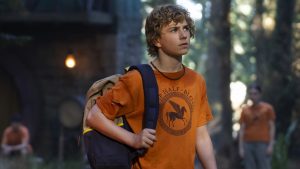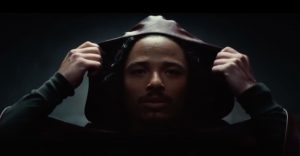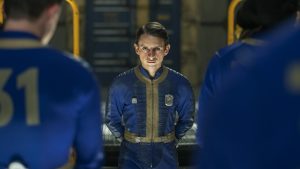
This article is presented by
Prehistoric creatures don’t come much more iconic than the Tyrannosaurus rex. There’s a reason why it’s called the “king”—the giant Cretaceous carnivore has been capturing people’s imaginations for over a century, cementing itself in pop culture in the early 1990s thanks to a scene-stealing performance in Steven Spielberg’s Jurassic Park. So, recreating the T-Rex for Life on Our Planet was no mean feat. “It’s possibly the most charismatic animal that’s ever lived,” says the series’ lead scientific researcher, Dr. Tom Fletcher. “And in many people’s eyes, it’s the most impressive animal that’s ever lived as well. So it’s some job to bring it up to date and to really do it justice.”
With 30 years of updated paleontological research to work from, the team behind Life on Our Planet set out to show a new, more accurate version of the T-Rex than we’ve ever seen before. Fletcher and the producers worked with Industrial Light & Magic, the effects house that had, fittingly, worked on Jurassic Park’s original tyrannosaur. “It’s obviously quite a big ask, if you work at ILM, to make a T-Rex,” says VFX supervisor Jonathan Privett. “For Life on Our Planet, there was the pressure of making it look incredible, but on top of that, Tom had waded through hundreds of pages of research. Our version is still pretty mean and ferocious and looks fantastic, but is more accurate to the science.”
Meat on the Bones
You may notice that Life on Our Planet presents quite a heavyweight T-Rex, much more chunky than previous depictions. Fletcher explains: “There’s a tendency for people to look at fossil skeletons and just put the bare minimum of flesh on top, sort of a shrink-wrapping. But the science of that doesn’t stack up—T-Rex was a brute!” Adding extra mass was just a first step in making Life on Our Planet’s T-Rex look real, though. “It’s also about the tiny imperfections that all living animals have that make them feel alive—the scars, the fat, the ligaments, the wrinkles, and the dirt,” says Fletcher. “Adding all that wear and tear and soft tissue to T-Rex might make it look bulkier, but it’s great that we’re moving away from hungry-looking dinosaurs. Ours has the heft you would expect on a healthy apex predator.”
In Fine Feather
The extra heft and external nuances aren’t the only changes; the show’s male T-Rex, in particular, has some snazzy new plumage. “One of the biggest changes since the original Jurassic Park came out is that we now know a lot of dinosaurs had feathers,” says Fletcher, who explains there was a fine line to tread when it came to deciding how many “feathers” the T-Rex might have. “There [became] a tendency with paleo art to stick feathers on every single dinosaur and make them really fluffy, which can look a bit odd. But even though Tyrannosaurus rex has relatives that had feathers all over their bodies, that doesn’t mean T-Rex itself did. You have to think beyond that. You have to think, ‘OK, T-Rex is a huge animal living in a hot climate—it would overheat if it had a full covering of feathers.’”
The team looked at things like hairs on elephants, a modern-day titan that’s used to warmer climes, to reach a scientific compromise: small quills on the nape of the T-Rex’s neck. “From a technical point of view, we discussed doing the quills as hair or feathers,” reveals CG supervisor Elizabeth Mitchell. “In the end, they’re a bit more of a solid model.” And the reason these quills are only on the male dinosaur? “Often, birds, which dinosaurs are related to—spoiler alert—have display structures and that kind of thing [on the males],” says Fletcher. “So that was a nod to the science there.”
Lip Service
A toothy visage was essential to making the T-Rex one of the all-time scariest movie monsters, but the science says otherwise.
“Possibly the most disappointing thing for the producers was covering the teeth with lips,” Fletcher laughs. “Their teeth are the size of bananas; they are ridiculously huge and most depictions show them exposed. So to go to a producer and say, ‘I’m really sorry, but actually, the evidence suggests they were covered up… You’ve got to put your argument together as a scientist and say: ‘Look at a lion, look at a Komodo dragon.’ There’s a clouded leopard with huge teeth—they’re massive but covered with soft tissue—it’s only when it yawns that you appreciate how big they are.
“There are lots of scientific reasons why the teeth should be covered up, and evidence has come through that they should be. So we follow the science at the expense of it looking frightening; we made it look more like an animal than a monster. But I think it’s more terrifying because it looks more realistic.”
Different Stripes
Another evolution for Life on Our Planet’s tyrannosaurs is their skin tones and markings, with dark stripes along their bodies and, for the adult male, distinctive reddish markings on its face. Fletcher says that paleontologists have found fossils of some extinct species that do carry information about external colorings and patterns, but T-Rex is not one of them— meaning there is “a little guesswork when we don’t have the skin or the feathers preserved, if we just have the bones.” That license has strict limits, though. “If, for example, you’re a really large animal on the savannah, you are probably going to be gray or brown,” he continues. “If you’re in a dense woodland and you don’t want to be seen, you have to break your shape up. There are rules in nature today that we have to abide by.”
As for the difference between the two dinosaurs? “Again, that was a bit of scientific inference,” admits Privett. “The suspicion is that there is some dimorphism, but exactly how that presents itself is hard to know. If we look at phylogenetics, the descendants of a T-Rex—birds and, to a certain extent, reptiles—do have that difference. Often, the males are more brightly colored in a display way, so we inferred it. We thought the end result looked believable and seemed appropriate.”
Family Dinner
One thrilling sequence sees an adult and two young T-Rexes chase down an unsuspecting Triceratops, with the youngsters playing a key role in the hunt—something that, again, we haven’t really seen before on screen. “T-Rex is such an odd dinosaur—it’s so bulky that some researchers have suggested that it probably couldn’t run, in the true sense of getting both feet off the ground,” says Fletcher. “The young T-Rexes look so different: they’re lean and graceful, with really long legs, and they could run fast like a velociraptor might. For a while, people thought the two were completely different species. The youngsters could chase things, but the adults couldn’t. So were the adults just scavenging, or were they doing something else?”
To solve this riddle, the researchers looked at fossilized “trackways,” which showed that very close relatives of the T-Rex sometimes moved in packs. “If you’ve got youngsters that are really mobile, really quick, and you’ve also got evidence for sociality, maybe there’s a division of labor,” Fletcher explains, “where the youngsters are chasing down something and the adult is immobilizing it. So that scene is very much born out of this idea that they were working together and there was some sort of cooperative hunting involved.”
Dancing Dinos
Another key sequence shows off a little-seen softer side of the T-Rex, with a male dinosaur attempting to catch the eye of a potential mate. The “dance” that he performs, again, is based on a mix of fossil evidence and phylogenetics. “Until we invent a time machine, we’re never going to see a T-Rex dance,” says Fletcher. “But what we do see in theropod dinosaurs elsewhere in the fossil record are trackways with scrape marks in the ground, where they seem to have been doing a display.”
The courtship ritual was also inspired by a number of modern birds, as well as alligators and crocodiles—“the other side of the dinosaur family tree,” according to Fletcher. “Crocodiles will produce really low bellows to attract females; birds are vocalizing all the time, and they’re doing dances and all sorts of crazy stuff. You obviously can’t scale up a small bird dance to a T-Rex—it would be too frantic and look odd—so we had to tone that down enormously. But there were common elements like head sways, symmetry, the deepness and complexity [of the sounds]….”
All in all, it makes for a surprisingly sweet moment between two giant prehistoric predators. “T-Rex was capable of quite delicate behavior—we now know that its jaw was covered in nerve endings, so was most likely very sensitive and tactile,” Fletcher explains. “It’s important to see different sides of creatures,” Mitchell adds. “The T-Rex is so iconic—we’re used to it being the big scary creature. So it was exciting to work on a scene where they’re doing these different, unexpected behaviors, rather than the norm we’re used to seeing.”
Roar and Order
To create the sound of the T-Rex, Fletcher and the team worked with Wounded Buffalo Sound Studios, which specializes in sound design for natural history filmmaking. Just as with the show’s VFX, sounds were recreated based on scientific principles.
“By looking at a cast of the T-Rex’s skull and its inner ear, you can see that the cochlea, which is the sound-receiving organ, is very long, so the animal was probably extremely good at hearing very low-frequency sounds,” says Fletcher. “If you can hear low-frequency sounds, your vocalizations are probably going to be low-pitched as well—crocodiles, for example, can produce very low, resonating sounds… and they do growl, which is pretty scary. So T-Rex was always going to be a low resonating, grumbling kind of sound, and that suits its size.
“The other side of it is using modern birds—nothing too complex, like a sparrow, but hisses are a probable sound. You can mix sounds that are a combination of the crocodile and the birds to come up with something that is likely. We’ll never know for sure, but by using anatomy and modern relatives, we can get pretty close.
“Wounded Buffalo has a huge database of modern animal sounds. So combining these things to make dinosaurs, I think, was quite fun for them. For the T-Rex, my note was always to make it as low as possible. I wanted it to be so low and loud that it broke people’s speakers because that’s probably what it would have done, but I think we would have gotten complaints!”
Life on Our Planet is streaming now on Netflix.
The post How Netflix’s Life on Our Planet Brought a More Realistic T-Rex to the Screen appeared first on Den of Geek.









